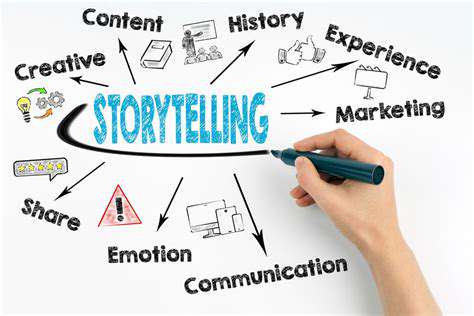Identifying the Need for Increased Awareness
Understanding the Scope of the Problem
Migraines affect a significant portion of the global population, impacting daily lives and productivity. The sheer number of people experiencing debilitating migraine attacks highlights the urgent need for increased awareness. This understanding extends beyond the individual sufferer; it encompasses the wider social and economic ramifications of this widespread neurological disorder, including lost workdays, healthcare costs, and the overall impact on quality of life.
Further complicating the issue is the often-misunderstood nature of migraine. Many people, including healthcare professionals, may not fully grasp the severity of a migraine attack or the chronic nature of the condition for many sufferers. This lack of awareness can lead to delayed or inappropriate treatment, exacerbating the problem and further impacting the patient's well-being.
Bridging the Knowledge Gap in Diagnosis
A crucial aspect of increasing awareness is improving diagnosis accuracy. Many individuals experience migraine symptoms without proper identification, leading to misdiagnosis and delayed or inappropriate treatment. Increased public awareness about the varied presentation of migraine symptoms, from throbbing headaches to nausea and visual disturbances, is essential to encourage prompt and accurate diagnosis.
Educating healthcare professionals is equally important. Providing comprehensive training and resources for diagnosing migraines, including distinguishing them from other headache types, will lead to more accurate diagnoses and better treatment plans. This includes recognizing the potential for comorbid conditions that can complicate migraine management.
Promoting Early Intervention and Treatment
Early intervention for migraine is vital for managing the condition effectively and preventing long-term complications. Increased awareness can empower individuals to seek help sooner, rather than waiting until symptoms become severe. This proactive approach is crucial for preventing escalation and mitigating the impact of migraine attacks on daily life.
Furthermore, greater awareness can foster a supportive environment where individuals feel comfortable discussing their symptoms and seeking professional help. This includes encouraging open communication between patients and healthcare providers, fostering trust, and empowering patients to take an active role in their own care.
Highlighting the Impact on Daily Life
Migraine attacks can significantly disrupt daily routines and activities, affecting work, school, and social life. Increased awareness can help individuals understand the profound impact migraines have on their lives, and encourage empathy and support from others. Recognizing the challenges faced by individuals with migraine can foster a more understanding and accommodating environment in various settings.
Encouraging Advocacy and Support Groups
Building a supportive community around migraine sufferers is crucial for managing the condition and improving quality of life. Increased awareness can encourage the formation of support groups and advocacy initiatives, providing a platform for sharing experiences, exchanging advice, and raising awareness within communities. This type of support is invaluable in helping those affected by migraines navigate the complexities of their condition.
Advocacy groups can also play a vital role in influencing policy decisions and raising funds for research. This collective effort can translate into better access to healthcare, improved treatment options, and ultimately, a better future for migraine sufferers worldwide. Ultimately, greater awareness translates into better support and improved treatment outcomes.
Promoting Understanding Through Storytelling

Promoting Cultural Awareness
Developing cultural awareness is crucial in today's interconnected world. It involves recognizing and respecting the diverse perspectives, values, and beliefs of individuals from various backgrounds. This understanding fosters empathy and tolerance, enabling us to appreciate the richness and complexity of human experience. We can achieve this by actively engaging with diverse communities, actively listening to others' stories, and challenging our own biases.
By learning about different cultures, we gain a deeper understanding of the world around us. This understanding helps to bridge divides and build bridges of communication and cooperation. It's essential to recognize that cultural differences do not imply inferiority or superiority; rather, they represent unique expressions of human creativity and ingenuity.
Strategies for Fostering Cross-Cultural Dialogue
Effective cross-cultural dialogue requires a commitment to active listening and a willingness to challenge preconceived notions. Open-minded communication is paramount to breaking down barriers and fostering mutual respect. Creating safe spaces for dialogue where individuals feel comfortable sharing their perspectives without fear of judgment is essential.
Utilizing various mediums, such as workshops, community events, and online forums, can facilitate meaningful interactions between people from different cultural backgrounds. These platforms provide opportunities for individuals to share their experiences, learn from each other, and develop a deeper understanding of diverse perspectives. This is key to building a more inclusive and understanding society.
Encouraging collaborative projects and shared experiences can foster a sense of community and belonging. By working together towards common goals, individuals can learn to appreciate the unique contributions of each cultural group and build strong relationships.
The Role of Education in Promoting Understanding
Educational institutions play a vital role in cultivating cultural awareness and understanding. Integrating diverse perspectives into curricula and teaching materials can equip students with the knowledge and skills necessary to navigate a multicultural world. This goes beyond simply teaching about different cultures; it also includes fostering critical thinking skills and encouraging students to challenge stereotypes.
Overcoming Cultural Barriers to Communication
Cultural barriers often arise from differences in communication styles, nonverbal cues, and values. Understanding these nuances is essential for effective cross-cultural communication. Developing intercultural competence involves recognizing these differences and adapting communication strategies accordingly. Being mindful of potential misunderstandings and actively seeking clarification can help to bridge these gaps.
By actively seeking to understand different communication styles and actively listening, we can create more effective interactions and build stronger relationships. It's important to remember that communication is more than just words; it involves understanding the context and the underlying meanings behind the messages being conveyed.